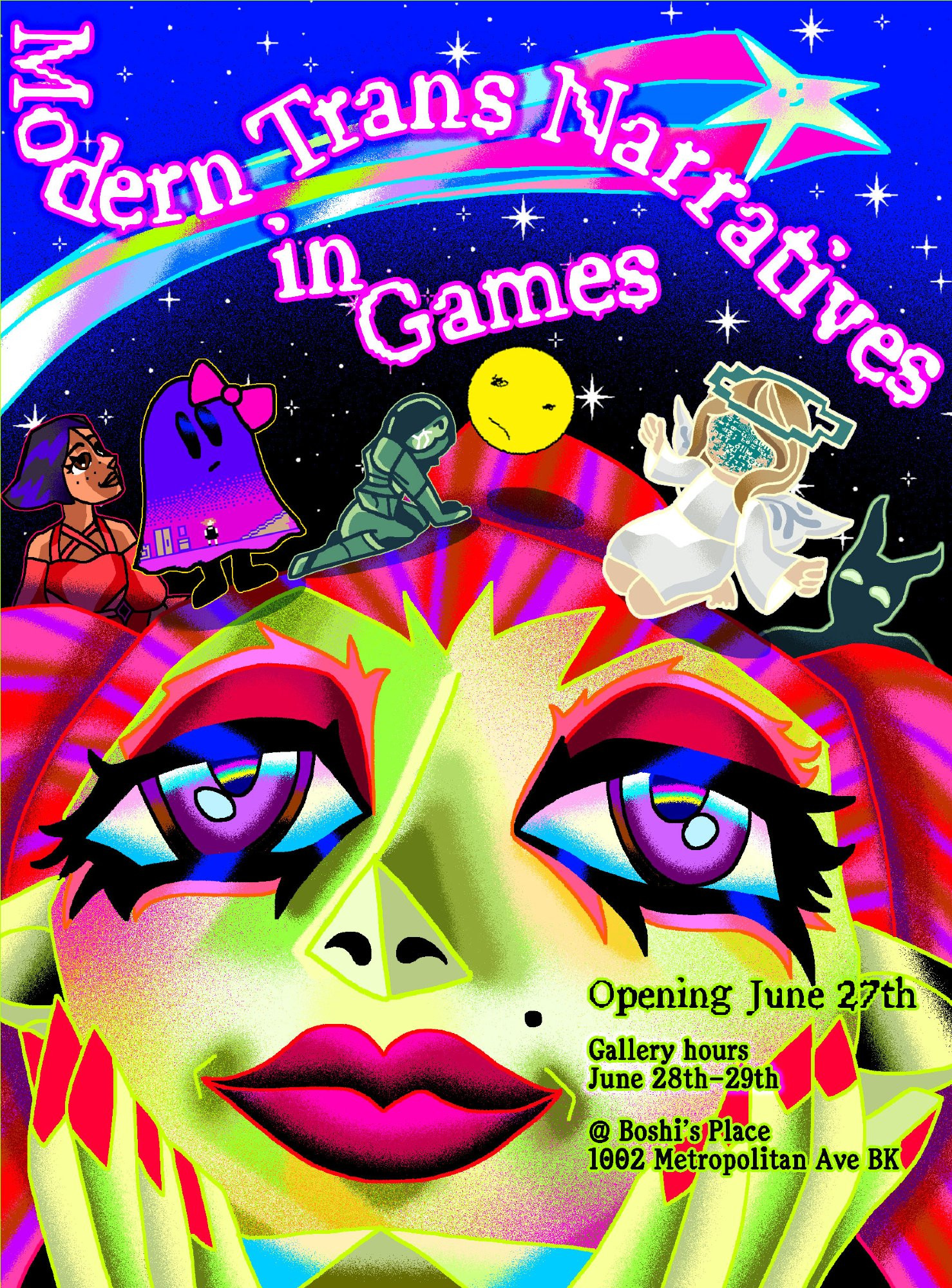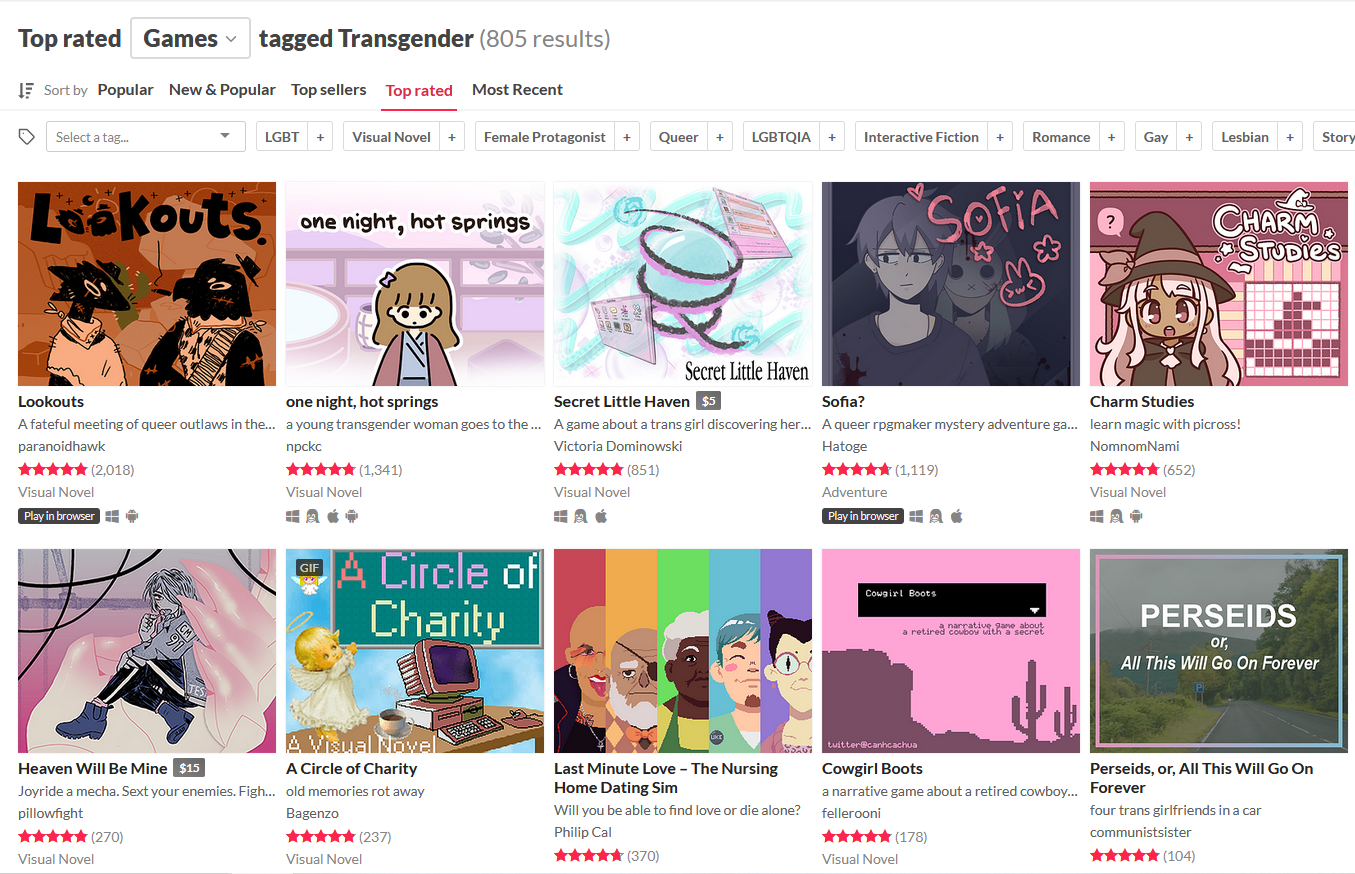What Makes a Modern Trans Game?
This weekend, Boshi’s Place in NYC is hosting a gallery called Modern Trans Narratives in Games, where Wingless Faires will be included (thank you!). I live 500 miles away, so I can't stop by, but I wanted to write something about the games chosen and what I think it means to be making contemporary trans games / art right now.

(everyone say I love you Velvet)
The first thing I noticed when I was contacted about this event is that there are zero games from the “queer games scene” of the early 2010s here (ie dys4ia, mainichi, problem attic, etc) that are normally present at events like this. That’s an interesting choice, and it must have been intentional when a lot of those former queer games scene people lecture within a few miles of the venue.
You could see the curation choices as just wanting to be more modern than the 2010s, or giving other games a chance to be exhibited. But I think what all these games really represent together is the nascent convergence of 2010s queer games and more recent itch.io-era trans narrative games, which is what I want to talk about.
Let's define those two movements, the way I see them:
2010s queer games are pretty well documented. I remember being in high school when this was happening and it wasn’t hard to draw connections between these games as an outsider, even if they weren't all actually coming from the same place. They were (as an outsider) pretty clearly tied to movements in games studies that sought to move away from rigid game design rules and instead think about how the design of a game can be used to make an argument or affect the audience. In that sense, many of these games felt like experiments with using game design as a means to talk about being queer or trans, rather than only expressing those themes through narrative. The narratives themselves were often simple and in service of the experimental design. I think more recently, trans horror games like Anatomy or Pagan: Autogeny carry this torch in the way they convey trans feelings through form.
What I'm calling itch.io-era trans narrative games is not so well-defined, so I'm going to focus more on it. It's easy to find, here it is, but I don't often see people talking about these games seriously. Despite that, they have a huge influence, and in a way they’re part of a “scene” with some common artistic values even if they're not written about that way.
As opposed to the 2010s queer games, the large majority of these itch.io games have essentially no gameplay. They often fit into established formats like visual novels, rpgmaker walking sims, bitsy games, twine games, etc. I think what we’re seeing with these devs, and their not-trans counterparts (ie Butterfly Soup), is that they're using games as containers for art and text, not really as “games”, whatever that means.
I think there's multiple reasons games have become this vessel for other kinds of media like this. One is that games have a much better self-publishing landscape than a lot of other artforms that are more beholden to publishers and MFA programs, and the infrastructure for self-published games is really strong because they've been distributed online for decades. There's also enough history of free games (with flash and early indie games) that free and self-published games have a more serious audience compared to self-published novels for example.
The result of that is a trans games tag that is saturated with digital artists and writers who are mostly just looking for a format that lets them draw and write on the internet with as little friction as possible, and who are not particularly interested in game design. The “genres” are literary genres, mostly memoir, slice of life / chick-lit, “essay”, romance, and erotica. They’re focused on writing, which fills a pretty huge void trans games had before this point.

These two sides of trans games feel hard to reconcile, but there's overlap in the audiences, and the ideas from both sides are established enough now that trans artists are influenced by both of them even if they weren't involved in either movement. What people do with these conflicting influences is just now starting to be seen. I think the games in this exhibition are “modern” in the sense that they are all post- these two movements. They were created in a world where the work was already done to break the rules of game design and to build a foundation of more straightforward trans narratives in games (which many of us were a part of).
All these games, to me, make an attempt to push at the boundaries of established formats of games (like the queer games scene did), without sacrificing the complexity of narrative those established formats allow you to have.
For example, Taylor McCue started out making twine games (with images), and now makes these 8-bit walking sim type games that maintain the complexity of her old work in a new format. Bagenzo and fotocopiadora both tend to work somewhere between traditional visual novel and weird multimedia thing depending on how straightforward they want to be. Yuen Hoang makes digital zines, and seems to use the open-endedness of games as a way to put their writing in whatever context they want it to be in (such as tumblr posts in genderfelt).
These games deviate from typical narrative conventions of itch.io games in some ways too. I have always loved how Taylor eschews trans memoir tropes with her eeriness and magical realism, as an example. All these games, in some way, reckon with the ubiquity of the realistic trans memoir-ish / essay-ish genres (not that these are bad, I love memoir), both by trying to find new things to say and new ways to say them.
For myself, I’ve always been skeptical of “game design” and the ways it can get in the way of narrative, even as I’ve experimented with different formats. Wingless Fairies was the first time I felt like I really knew why I was playing with the format of a game, other than just wanting to try something new. Despite being a fan of how queer games of the past were chopping up video games and putting them back together, I think I needed to spend time writing more straightforward visual novel type games for a while just to learn how to write something about being trans that hasn’t been said a hundred times before. There was value in both for me, and now I’m doing my own thing, I guess.
I think that’s the story for a lot of trans artists now. This push and pull between “queer” form and queer narrative seems present in other media too. There is this tension, especially in contemporary trans art, between radical experimentation in form that is sort of destructive and hostile to singular meaning, and this need to tell the truth of our lives and be specific and unassailable that veers into nonfiction. I sometimes see these differing attitudes as remnants of postmodernism vs modernism, or some sort of spiritual battle between anarchism and socialism in art. But these are just ways I think about it in my head where it doesn’t have to be completely true.
What is true, is that we live in the world where these two sides of trans art + games exist. Regardless of what that means to you or how you want to respond to it, we’re creating art in that context. It’s worth understanding that context and learning from it if you want to create something meaningful.